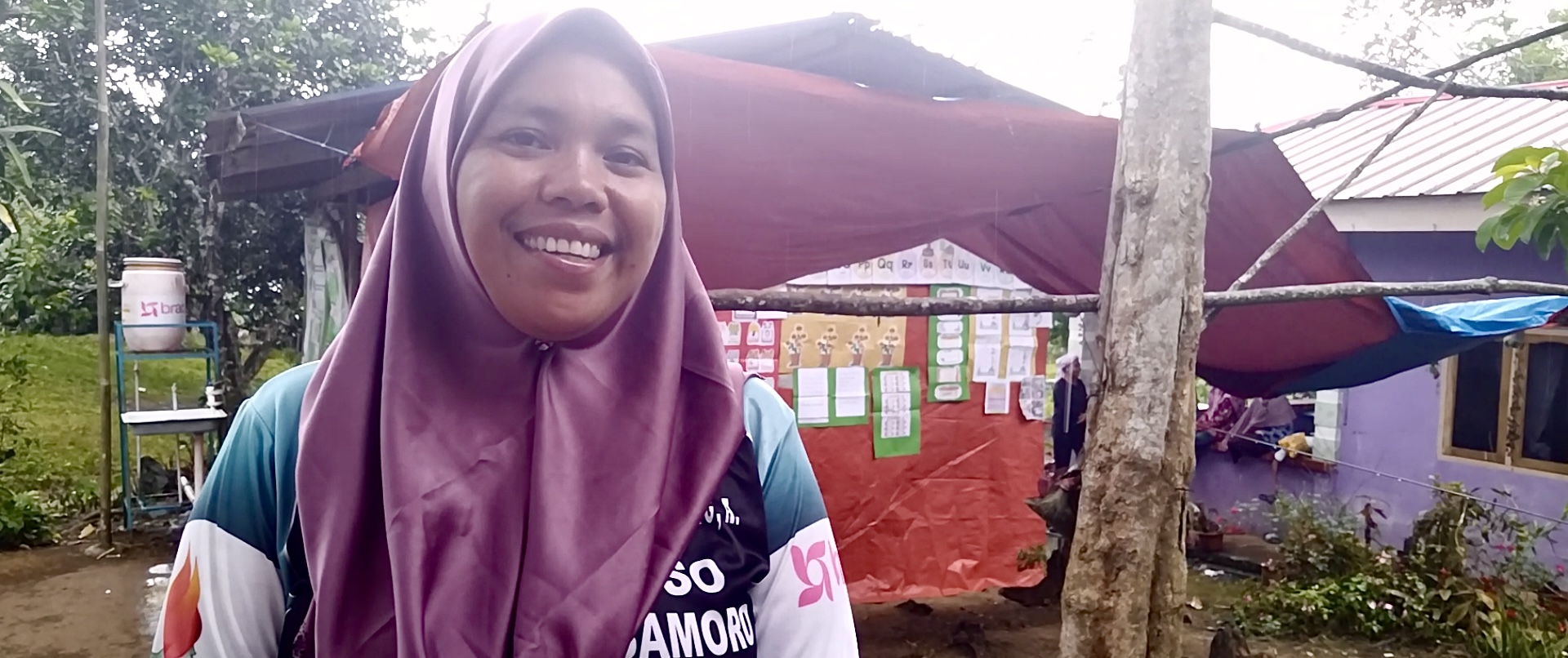
AKAP-Bangsamoro gives hope: A story of passionate teacher in far-flung community of Lamitan

Teachers prove that they are modern-day heroes as some of them go above and beyond just to teach their students. Ambay Alimasang, a learning facilitator from Lamitan City, is one of the examples of teacher who serves passionately and effortful in giving quality education to K-3 students in the remote area of Lamitan despite of the challenges and risks.
Ambay teaches in Bohe-Nange Learning Center, a learning center situated in Sitio Nangka, Barangay Bohe-Nange, Lamitan City – one of the school-less barangays in the city. Most of the residents in the area are dominantly Yakan tribe. Ambay travel for several hours, crossing the bumpy road and had to pass mountainous spot just to get to her students. She would have to hitch a vehicle called Wilis- a vehicle that transports rubber, or sometimes, she rode on a motorcycle. When she is not getting a ride, she has to walk for more than an hour and it becomes longer, riskier, and more challenging when she does it during rainy season. She needs to be careful as paths become slick and slippery. Walking for an extra mile made it harder for her as she gets out of breath before finally reach the learning center. But for Ambay, this is not a hindrance to continue to serve the young people in her community.
Hindi po biro yung nilalakad namin pero hindi na namin yun iniisip dahil alam namin na maraming batang naghihintay sa amin. Maraming mga umaasang magkaroon ng magandang edukasyon, parang uhaw at gutom sila sa pangangalap ng kaalaman, dahil din siguro sa layo ng lugar at malayo sila sa downtown kung saan may mga malalaking paaralan.[It is hard to walk for more than an hour just to be here, but we don’t think about that anymore because we know that there are students who patiently waiting for us. They are hoping to have a good education, and eager to learn because they have not given the opportunity to go to school due to the distance from the city.]
AKAP-Bangsamoro gives hope
Due to the distance of the school, many young people in the community prefer not to pursue their education. For that reason, aside from the challenges of traveling on a bumpy road just to teach the students, Ambay was also putting lots of effort in encouraging the parents and their children to learn from school. One of the interventions in order to address the challenges is to make the school more accessible and closer to the community and this has been what the program is currently doing. AKAP learning center has bridged the gap and gradually address the challenges. Ambay have been given the hope of a better education because of the AKAP-Bangsamoro program.
AKAP-Bangsamoro program gives hope not only to the learning facilitators but most especially to the children. When ambay arrives at the learning center, you can see the happiness and eagerness of the students to learn and gain more knowledge. With years of teaching and by the help of the AKAP-Bangsamoro program, children already had the knowledge on how to read, write and count. As a result, the hardship and tiredness of the everyday journey in going to the learning center, passing those obstacles and surpassing those challenges have been replaced by happiness and fulfillment, and seeing their students learn and improve every day, for Ambay, it was totally worth it and a great experience to remember.
Continue to serve, create an impact
A beautiful classroom might give an impact to the learning of the students, but having no great classroom or an established educational institution is not an obstruction for Ambay to teach. She is making ways to make the learning center more creative. They just use the trapal (heavy and waterproof sheet of material) as a temporary learning center.
“Ako para sa akin hindi sapat na dahilan na wala kang classroom ay hindi kana magtuturo dahil ako mismo nagi-initiative na gumawa ng paraan para magmukhang classroom ito. Minsan naman ay nasa ilalim lang kami ng mga puno ng bayabas pero kahit saan kami napapadpad dala parin naming yung mga visual aids (props) namin at iba pang learning materials” [For me, it’s not enough reason that if you don’t have a classroom, you won’t teach, because I personally take the initiative to make our temporary learning center look like a classroom. Sometimes, we held our classes under the guava trees, but no matter where we are going to hold our classes, we will still bring our visual aids (props) and other learning materials].
Under the trapal and guava tress, Ambay gets emotional when she presented a picture of a school to her students. She tells them that this is what a real school looks like and they just create an imagination that they are currently taking their class in that place. Most of her students have never seen a real school building, what Ambay did, she drew a school and she presents it to her students. Ambay always gave a piece of advice to her students that this situation is not a hindrance to pursue their education and poverty is an obstacle to achieve their dreams.
(This feature article is contributed by the Consortium of Bangsamoro Civil Society. CBCS is among of CSO education partners who implemented Abot-Kaalaman sa Pamilyang (AKAP) Bangsamoro Program with support from Pathways, the Australian Government, and BRAC Philippines. AKAP Bangsamoro is a flagship program of MBHTE Minister Mohagher M. Iqbal/BangsamoroToday)

